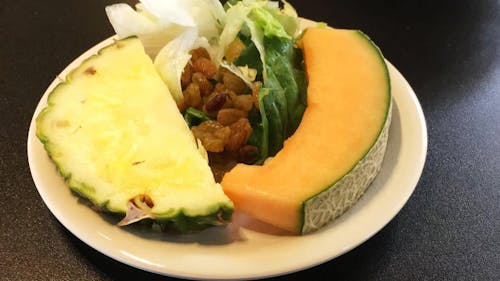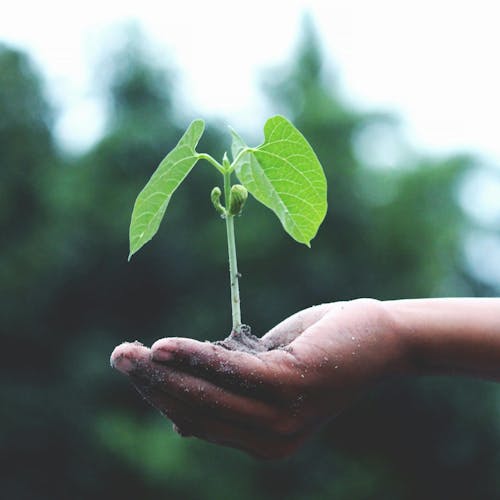Get in touch with your environmental side, try veganism

Sitting outside of Honeygrow on Rutgers University’s College Avenue campus, Rushil Patel munches on his rice noodles, glazed with sesame garlic sauce and sprinkled with vegetables. “It’s really weird. It’s a weird story,” he muses with a chuckle as he recalls exactly how he decided to strip his diet down to the essentials.
“We lived in India before — when we moved here I was in the American school system and I ate whatever they had, I was fine with eating meat,” Patel says. “Sometime in 2011 or 12, I was like ‘I wanna start working out, I wanna get big’ — I was looking up Hugh Jackman workout routines and stuff like that, so I saw that some headline said that Hugh Jackman was going to be training with a vegan trainer — I was like, ‘Oh, that’s interesting,’ I didn’t even know what vegan meant at that point.”That trainer’s name was Brendan Brazier — a Canadian triathlete renowned in the vegan community. His website describes him as being “regarded as one of the world’s leading authorities on plant-based performance nutrition.” He’s inspired many athletes, and was Patel’s introduction into veganism. Brazier lingered in the back of his mind for another two to three years before he finally totally committed to it as a sophomore in high school.
Patel cut meat completely out of his diet in 2012, mainly for health concerns. “Saturated fat, cholesterol — your body doesn’t need that stuff, it’s really harmful, causes many diseases,” Patel said.
He hadn’t yet made a connection between his diet and animal rights at that point, and was still eating dairy. As he became more and more interested in the subject, he discovered the way animals are actually exploited and abused, even to produce dairy products like milk and cheese.
“I realized what happens in the industry, and how the system works,” Patel said somberly. “With that information that I had, I wouldn’t have been able to continue doing the same things I used to, that’s why I decided to become vegan.”
Now Patel is a Campus Organizer for the Humane League , a 501(c)3 animal advocacy organization that works to protect all animals through public education and campaigns.
“We’re taught that you love certain animals, you use certain animals, you hunt certain animals, and you eat certain animals,” said Jenine Motta, Programs Director at the Animal Protection League of New Jersey. That logic is a big issue among vegans and vegetarians — why do we keeps some animals as pets and form a connection to them, but consume others?
It’s called intensive factory farming, she said. A dangerous amount of animals are crammed into a small space — and when that happens, the amount of waste they produce has to go somewhere, Motta explains. “People want to point at cars, or that we should be recycling. Which are all good things to do, you know, drive an environmentally responsible car and recycle, but by far the biggest contributor to environmental pollution in the form of climate change is animal agriculture.
It would seem obvious that not consuming animals is key to ending animal cruelty, but many people are still confused about why consuming dairy products is harmful to both animals and the environment. Patel himself didn’t know why he should stop consuming it until he did a little more research.
Most milk comes from factory farms across the United States. Just like humans, a cow must be pregnant to lactate. Once the calf is born, it's taken away in a matter of one or two days, so it doesn't let it drink too much of the cow’s milk. If the calf is female, it can become another dairy cow, or if not, it’s killed for veal or beef. Dairy cows are also not permitted to live out their days in peace — they’re killed off once they stop being able to lactate.
“Cows, pigs and all these animals have connections with each other and their offspring just like we do with our kids — we may not understand that, but they feel what we feel as well — the practices are just cruel,” Patel says. “Essentially, you’re taking a sample of bull semen and inserting it into the cow's vagina, I can’t stand for that.”
Here’s the good news — one thing everyone can agree on is the fact that veganism and vegetarianism is getting more popular, which makes it so much easier to cut animal products out. “It’s probably the most difficult aspect [of veganism], socially — because you’re still in the minority, but that’s changing all the time,” said Freya Dinshah, president of the American Vegan Society and editor of American Vegan Society’s magazine. “I’ve been vegan for 56 years, and when I became vegan, you couldn’t go and find all these options. You couldn’t find tofu unless you went to San Francisco or New York Chinatown. You just had to make things from scratch yourself and pack your own lunch.”
None of this means it’s not a difficult transition, especially for college students like Patel who are running from class to work and just beginning to cook for themselves. He took a few years wavering between being a vegan and vegetarian before he finally cut out all animal products in February 2016.
“Anything you do takes transition. It does take a lot of learning, but everything takes learning,” he says. “Like, going from high school to college was a transition. Getting into a relationship is a transition of sorts, and breaking up is a transition. Any change in your life is a transition that you adjust into after a while and it just becomes second nature. Like you’ve always done it.”
It’s a change that takes careful planning and effort, but it’s like any other change in routine. There’s an adjustment period, but then it’s second nature. “It’s like driving a car,” explained Charles Stahler, co-director at the Vegetarian Resource Group, an organization that educates the public about vegetarian and vegan diets. “You first get your license, and you think this is all going to be so hard. But once you get going, you realize it’s all automatic. And you can make it as easy or as complicated as you want — it all depends on the person.”
Vegans don’t have to even suffer while eating out these days either.
“Rutgers is very vegan-friendly,” Patel said excitedly as he lists off the restaurants in New Brunswick with affordable and tasty vegan options.
Ta-Ta’s Pizza on Hamilton Street is one and they serve vegan pizza and fat sandwiches. Even chains like Qdoba and Chipotle have options that are easy to find.
“For me, they check out all my criteria of being reasonably healthy, filling and pretty inexpensive — and vegan, of course,” Patel said.
He’s also treasurer of the Rutgers Veg Society, a club that provides students with a meeting place to allow for support and growth within the Rutgers vegetarian and vegan community through meetings and community outreach activities. This is another great way to help the transition from eating meat to going veg. but it’s a journey.
“It’s not about perfection — let's say you’ve been vegan for a year and you had a bite of milk chocolate or a slice of pizza,” Patel said, boxing up his leftover stir fry. “That doesn’t make you not vegan. It’s not like a title you have to uphold, it’s doing the best you can. That’s what it’s about.”



